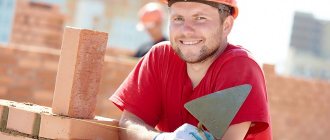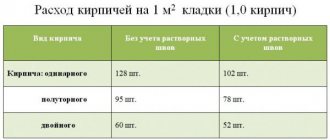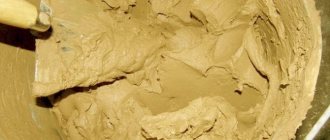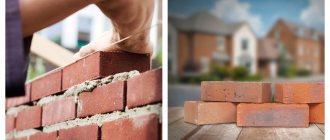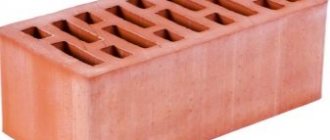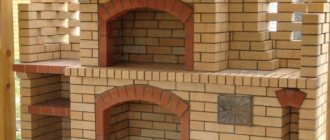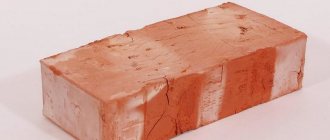Single and one-and-a-half bricks: comparison and advantages
One-and-a-half bricks have been valued by many builders for a long time. This popularity and demand is due to the reliability and durability of the material.
It is resistant to adverse environmental influences and can withstand a large number of freezing-thawing cycles. In addition, the material is not susceptible to mold and mildew.
But a one-and-a-half brick has a size that is 1.35 times larger than the standard one. And this is not a disadvantage, but rather an advantage, because due to this you can save time on construction.
Due to the size, savings in cement mortar are also achieved, almost twice as much as compared to a single type of brick.
The material has several varieties. There are different types of bricks: facing bricks and building bricks. The side edges of facing bricks can be corrugated, smooth or textured.
There are also silicate and ceramic bricks, depending on the manufacturing technology and the main raw materials used.
The benefits of building with one-and-a-half bricks are obvious. Even with simple calculations, it can be seen that per cubic centimeter the consumption of a single brick is 394 pieces, and a one and a half brick will require 302 units.
If load-bearing structures are being built, then one-and-a-half bricks can be used in combination with single bricks. Due to this, you can reduce the cost of material and masonry mortar.
The height of a one-and-a-half brick is only 23mm greater. But this small difference helps speed up masonry work by 30%.
The advantage of a one-and-a-half brick is also its weight, which is only one third greater than a single brick. Thus, the weight of the erected building will be less than that of a single building. And this allows you to implement more complex architectural forms with a small load on the foundation. In many cases, when building from a single standard brick, such ideas have to be abandoned.
You can purchase one-and-a-half bricks with delivery at a competitive price. Just contact us
Single KKK
Product Features
This type is designated by the Russian letters NF, that is, “normal format.” This is the thinnest brick considered today. It looks like a parallelepiped in one of the many red shades. It can have a smooth or textured, glossy or matte surface, and can also be solid or slotted.
Now let's talk about the dimensions of a single red ceramic brick and find out how much it weighs.
Dimensions and weight
The length of the products is 25 centimeters, width – 12 centimeters. The thickness is 6.5 centimeters.
- The weight of one ceramic single red brick in a monolithic design varies from 3.2 to 3.6 kilograms.
- If the brick has cavities inside, then its weight decreases and ranges from 2.3 to 2.8 kilograms.
This video will tell you more about the dimensions of a single red brick:
Varieties and applications
- solid products (with air cavities inside less than 13 percent) and hollow or slotted (with through or incomplete internal holes of various shapes). The total volume of voids in the latter case can be up to 50 percent.
- In addition, there are construction (without special finishing) and facing products that are used for the effective design of facades and the manufacture of decorative elements. This type of brick is also called face brick. It can be polished, covered with glass glaze, engobe (matte clay glaze), or have embossing and relief on the surface.
- Construction (ordinary) brick is used for the construction of walls, partitions, plinths, and foundations. Work from it can be done both inside and outside buildings.
We should also talk about the cost of a single red ceramic brick.
Prices
- On average, the price of building red ceramic single bricks (both solid and slotted) is about 9 rubles per piece.
- Facing bricks can have different costs, depending on the type of surface treatment. It ranges from 10 rubles and above.
Properties and types of bricks
The brick is extremely durable and resistant to moisture, and its price is quite affordable. Its dimensions are 250x120x88 mm. Using one-and-a-half bricks during construction, you can save both material resources and time spent on work.
Before purchasing materials for construction, determine what exactly is needed for the job.
Based on their purpose, brick is divided into facing (its side edges can be smooth, corrugated or textured) and construction.
According to the type of production, it can be silicate or ceramic - they differ in both raw materials and production method. Ceramic products are formed from a mixture of clay with additives that improve the function of the material and fired. The usual weight for solid ceramic bricks is 3.5-3.8 kg. More often they are used for cladding, for the construction of walls, fences, partitions, and such a property as fire resistance allows the material to be used for laying stoves and fireplaces.
Silicate brick is a little lighter and softer. To make it, you will need a mixture of sand and lime, from which bricks are formed and dried under certain conditions. But its strength is much less. It is not as versatile as ceramic - it can only be used for the construction of walls and partitions.
Dimensions of a single facing brick
Single brick size
Hyper-pressed. High pressure is used for its production and this gives it strength, which is very high in relation to other types. The dimensions of a single facing brick can be as follows: width – 120, 90 and 60 mm. The standard length is 250 mm, and the height is 65 mm.
Ceramic. The production of this type is more complex, since the process is energy-intensive and expensive. During production, a certain temperature regime must be observed. The standard size of this facing brick is: length 250 mm, width 120 mm, and thickness 65 mm. To make the product lighter, it has special voids. They not only make the brick lighter, but also improve the thermal insulation characteristics.
Clinker. Very durable material. In Europe you can find buildings made of this brick that are several hundred years old, but they are still just as attractive. This indicates high strength. Mainly used for cladding facades. High-temperature firing is used, which gives the product uniformity and eliminates the formation of voids. It has the same dimensions as hyper-pressed brick.
You might be interested in:
Technology of laying facing bricks.
How to cover a metal sauna stove with brick?
How to make a strip foundation for a fence with brick pillars?
Brick structure
The structure of the material can be solid or with voids - these types have slightly different characteristics. The voids in the brick are made so that less raw materials are wasted during the manufacture - they occupy approximately a third of the total volume of the element. But its design is thought out in such a way as to withstand a fairly large load, and thanks to the presence of cavities, it retains heat well.
A solid one, that is, a full-bodied one, has better strength, but it is also a little more expensive. Other, less common varieties have been developed for lightweight masonry: porous, hollow, perforated. Strength and light weight are more in demand here.
Which brick is better
Which brick is better
Brick is used to build dachas and cottages, residential buildings and industrial buildings, erect internal partitions, foundations, fences, lay chimneys, barbecues, stoves and fireplaces, use them for interior and exterior decoration of buildings, pave sidewalks and paths. There are many other building materials, but brick remains popular today. The construction market offers a large number of bricks of various colors and quality.
Many people are concerned about the question - which brick is better?
? We will try to talk about the types of bricks and the rules for choosing them in order to choose the good brick that you really need.
Which brick is better?
You need to have a complete understanding of the different types of bricks and their properties.
The most popular types of bricks:
Silicate (white) - consists of quartz sand, lime and additives. Used for the construction of walls.
Ceramic (red) - made from clay, water and additives. The mixture is mixed, bricks are formed, then dried and fired. When you hit a good brick, it makes a ringing sound. Products must have a quality certificate. Suitable for all types of buildings.
Hyper-pressed - contains rock crushing screenings, cement, water and dye. Used for decoration (cladding) of buildings.
Clinker - made from refractory types of clay and fired until completely baked. They are used for finishing facades, for interior decoration; they are used to lay fences, columns, bay windows, sidewalks, steps, etc.
Fireclay (fireproof) - the basis is baked fireclay clay. Used for fireplaces and stoves.
People often ask which brick is better – silicate or ceramic.
For different construction work, different types of white or red bricks are used, which differ in certain properties. There are restrictions on the use of silicate (white) bricks.
White brick is not recommended for use where there is constant contact with water and at high temperatures. Therefore, when building foundations, cellars and basement structures, laying stoves, baths, and chimneys, certain brands of red brick are used. When asked which brick is better - white or red, the answer is that they can be neither better nor worse. Each type of brick is good in its field of application, in accordance with its technical characteristics. If you choose based on price, which one is better, then definitely white. It is much cheaper than red. For each type of brick, there are GOST standards for the basic properties.
Which red brick is better? The brick has its own marking according to its tensile strength (which can withstand a load per 1 cm2). For single-story buildings, bricks M100 and M125 are used, for multi-story buildings - from M150 to a maximum of M300. We also look at the frost resistance index - F, which indicates the number of freezing and thawing cycles. The lowest value is F25, and the most frost-resistant are F200 and F300. Depending on the climate, choose the required brand of brick.
Which sand-lime brick is better?
Like red brick, sand-lime brick has a tensile strength grade. M100 is used for low-rise construction (1-3 floors). For multi-story construction, choose M150 or M200.
A high-quality brick must have the correct geometric shape, without chips.
Solid and hollow brick. Which brick is better, solid or hollow?
Solid bricks are produced without holes or may have no more than 13% of them. This product has quite a lot of weight, high strength, but it does not hold heat well. Suitable for load-bearing structures and foundations.
Hollow bricks are produced with holes. Due to the voids, it retains heat well. When asked which brick holds heat better, the clear answer is hollow. This product is lightweight and reduces the load on the foundation. Such bricks are used for internal partitions and cladding of facades (their insulation).
As a result, the choice of a certain type of brick depends on the characteristics of the object being built.
Single, double and one-and-a-half bricks.
The following questions often arise: which brick is better, single or one-and-a-half, and which double ceramic brick is better.
A single brick has dimensions
– L 250 mm, B 120 mm, H 65 mm.
One and a half brick with dimensions
: L 250 mm, B 120 mm, H 88 mm. Used for lightweight masonry. They are produced hollow, perforated and porous.
Double brick has dimensions
– L 250 mm, B 120 mm, and H 138 mm. They are produced with holes (slits) and are used in lightweight masonry. Double brick has different properties, which depend on the additives and type of clay, and is available in various shapes and textures. The choice depends on what you are going to build - a foundation or a building.
In 1 m of masonry in height there are 13 rows of single, 10 rows of one and a half and 6.5 rows of double bricks. Stronger masonry made from taller bricks.
Other types of facing bricks
In addition to one-and-a-half elements, single or double bricks are used for cladding . Single ones have standard dimensions of 25x12x6.5 centimeters. Double - 25x12x138 centimeters.
Bricks are also classified according to their filling: they can be solid or hollow. Hollow cladding elements significantly reduce the load on the foundation part of the building.
Depending on the raw materials and manufacturing method, facing bricks, regardless of the size of the element, can be:
- silicate;
- ceramic;
- hyper-pressed.
Each type has its own characteristics, so the choice must be focused not only on the size of the brick, but also on the composition and structure. The color of the material is also important to ensure decorativeness .
Facing brick: to make the façade of the house impeccable
The construction of a private house is accompanied by the desire to combine the comfort and practicality of housing with a presentable appearance. The facade of any building is its face, which is looked at every day by the owners of the house, their guests and random passers-by. Therefore, it is important to carefully approach the issue of finishing a building, because the wrong material can become unusable or lose its attractive appearance in a short time.
A popular option for finishing material is facing brick, which is also called facing or facade. It is often preferred in the construction of facilities of any level - from residential buildings to large cultural complexes of regional importance. There are many types of facing bricks on the building materials market, but which one should you choose? This is discussed in our article.
Facing brick
The size of a single facing brick is the same as that of an ordinary brick. The difference lies not in size, but in quality requirements. Products intended for facing masonry must have increased frost resistance and resistance to mechanical damage. Therefore, a different mixture is prepared for them, if we are talking about ceramics, and one spoon and pokes are covered with glaze. Sand-lime brick, which is made from lime and sand by pressing and autoclaving, does not need this.
Most types of ceramic and silicate suitable for facing masonry are hollow. Solid bricks are also used, for example, clinker or some types of silicate.
What to pay attention to
Despite the fact that there is a standard for the size of facing bricks, you should be careful when calculating its quantity per masonry. This is due to the fact that the equipment in brick factories is old, quality control is poor, and deviations from standard sizes are a frequent occurrence.
The currently fashionable facing material of yellow, red and brown colors with different surface textures looks great, but its sizing is a sore spot.
Its length ranges from 248 to 253 mm, width - from 118 to 122, height varies within 2 mm, but sometimes this is critical: masonry made from it looks good on a thin seam. When a mason tries to evenly distribute the bricks throughout the masonry, in some cases the jointing does not fit into the seam, and in others the mortar fails. Recessed rectangular seams (so-called bar laying) only partly solve this problem. Products of different sizes may appear in the same batch.
There is a variation in height for one-and-a-half (widened) sand-lime bricks. With a standard height of 88 mm, it is found in both 85 and 92 mm. Moreover, on opposite spoon surfaces, these dimensions may differ for one individual product.
Way out
Today, such types of facing masonry as three- and six-row, masonry with diaphragms, double cross and Gothic, when dressing is carried out on a quarter of the brick, have lost popularity. This is partly a consequence of the fact that the material for masonry walls is increasingly becoming ceramic stone and large-sized blocks, and when they are capable of being combined with facing masonry, both masons and designers are simply too lazy to do this. Therefore, the main type of brick cladding has become chain masonry with half ligation, when length matters.
To avoid getting into an unpleasant situation, it is advisable to measure samples from different pallets before starting work and identify the difference, and then lay them out dry. This will help maintain the average thickness of the vertical seam if you do not move the brick to the side in subsequent rows.
The difference in height can be controlled using an order or a simple tape measure.
Facing brick vs ordinary brick, silicate brick vs ceramic
When choosing bricks for construction, the question often arises which of the presented types is better. But this formulation of the question is not entirely correct. There are many varieties of this building material, and each of them has individual qualities and purposes.
For the construction of internal walls and partitions, as well as external walls of the building, ordinary brick is used. Such a product, in accordance with interstate and national standards, ensures the performance characteristics of brickwork. At the same time, unlike facing brick, the issue of external attractiveness of the material fades into the background.
Ordinary brick is not used for cladding the facade of buildings or its elements, since cracks and chips are often found on its surface. For ordinary bricks, appearance is not important. And the requirements in GOST 530 2012 for appearance are much lower. Therefore, when constructing masonry from such a material, the surface needs to be subsequently treated with plaster or decorative mixtures. Similarly, facing brick, as a rule, is not used for the construction of structural elements: in any case, the construction of a frame is necessary, and only after that the external finishing is carried out.
When producing facing bricks, chips longer than 1.5 cm and cracks are not allowed. In addition, such products may have a color tint or undergo additional texture processing. Therefore, they have a wide range of applications: cladding buildings, construction of fences, fireplaces, individual buildings. Therefore, the cost of facing bricks depends on the color and other appearance parameters.
Performance characteristics of bricks
Despite the large differences in terms of aesthetic appeal, facing bricks and ordinary bricks have common performance characteristics.
- Durability . It lies in the ability of the product to withstand external loads without subsequent destruction. The strength indicator is expressed in the numerical part of the brick brand: for example, a product of the M100 brand is capable of withstanding a load of 100 kg per 1 cm 2.
- Moisture absorption . It is expressed in the difference in the mass of dry and wet bricks, which is important to ensure the strength of the structure. For example, for use in environments with aggressive weather conditions, face clinker bricks are used, the moisture absorption rate of which should not exceed 6%. For other products, moisture absorption above 6% is allowed [1]: for facing - 8-10%, for ordinary - 12-14%, for interior work - 16%. The water absorption level of ceramic bricks can range from 6–14%. The indicator is determined when the products are saturated in water at a temperature of 15–25 ° C at atmospheric pressure or under vacuum, as well as in boiling water according to GOST 7025-91. Ceramic and silicate bricks and stones. Methods for determining water absorption, density and frost resistance control.”
- Emptiness. Taking into account this indicator, all products are divided into hollow and solid, depending on the presence of internal voids. Each type has different operational properties and range of applications. Hollow facing brick is lighter, retains heat better, but is less durable. Therefore, it is used for cladding to protect the building from cold and wind. For the construction of external walls, solid ordinary brick is used, which is highly durable but less heat-intensive. When producing solid facing bricks, more raw materials are consumed, so its price is much higher.
- Frost resistance. This indicator is responsible for maintaining the integrity of the brick during freezing and thawing. If the frost resistance of facing bricks is low, its price per m2 will be lower, but after several cycles of temperature changes it will begin to collapse, peel off or lose color. The frost resistance indicator is directly related to the product’s ability to absorb water.
- Fire resistance. This indicator affects the temperature the facing brick can withstand. This characteristic is especially important when finishing fireplaces and chimneys. Silicate facing brick (sand-lime) can withstand temperatures of 300–600°C, for red ceramic products (made from clay) this figure is higher - 800–1200°C, for refractory bricks (fireclay and quartz) - 1300°C, for industrial refractory (lime-magnesium and carbon graphite-coke) - 2000°C.
Types of bricks and their characteristics
Slotted bricks are available in a wide range, so you can easily purchase the most suitable material for the construction of a particular building. Products are classified according to a number of features:
- size;
- shape and number of slots;
- purpose;
- properties.
Shapes and number of slots/
Slotted products come in different sizes: single, one-and-a-half and double bricks are available on sale. For the construction of large objects, slotted double bricks are most often used, because it significantly speeds up the work process and reduces the consumption of cement mortar. In addition, this material can be laid in 1 row, and at the same time the strength and thermal insulation characteristics of the structure will be quite high.
The number of cracks in a brick can vary between 15-55% of its total volume
It is important to consider that the more voids in the product, the lower its strength, but at the same time the thermal insulation qualities will be much better. The shapes of the holes are round, square, rectangular and oval. As for the purpose, slotted bricks are divided into the following types:
As for the purpose, slotted bricks are divided into the following types:
- Porous - intended for cladding work. This material is lightweight due to its porous structure, but at the same time is able to provide the building with good heat and sound insulation.
- Cement-sand brick is the cheapest brick, the characteristics of which are in no way inferior to other materials. For its production, cement, sand and synthetic additives are used.
- Thermally efficient - a material with low thermal conductivity and low weight. It allows you to create lightweight structures with high performance. Thermally efficient single slotted brick, when laid in 1 row in winter, will retain heat in the building, and in summer it will provide pleasant coolness.
- Diatomite foam - intended for the construction of objects that are exposed to high temperatures, such as blast furnaces or smelters. Such products can withstand up to 900°C. In conventional construction, diatomite foam bricks are not used, which is explained by its high cost.
- Ceramic is a material with an aesthetic appearance and high thermal insulation properties. It is used for interior and exterior wall decoration.
https://youtube.com/watch?v=R27ML5G7le8
List of sources
- vse-postroim-sami.ru
- stroy-podskazka.ru
- kubkirpich.ru
- kirpichmaster.ru
The difference between single and one-and-a-half bricks
The proportions of a single brick are:
- height – 6.5 cm;
- width – 12 cm;
- length – 25 cm.
These dimensions of a single brick are the most suitable for its laying.
The proportions of one and a half bricks are:
- height – 8.8 cm;
- width – 12 cm;
- length – 25 cm.
Over time, after the single brick, one-and-a-half bricks with the above dimensions appeared in production.
